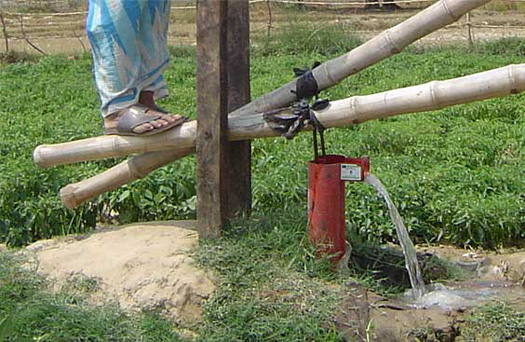
Treadle pump developed by IDE (International Development Enterprises). The cost of the pump, including installation, ranges from $20 to $100
Consider this dilemma: a poor farmer in Tanzania has a small, dusty plot of land where she struggles to grow mchicha (think spinach) and tomatoes. She and her kids lug water from a nearby well. She cannot afford fertilizer. She cannot afford a treadle pump to bring more water to her crops or a drip irrigation kit to more efficiently use her water. The cost of these products is trivial to us. Do you give the poor farmer a pump if you know it will transform her crops and move her family from just scraping by into the middle class? What if you knew that with your donation, she would be able to make enough money to send all her kids to school, not just her oldest son? It’s hard to say no, isn’t it? But you should.
“Free” is a big source of debate in my community, design and development — the design of products that will enable new sources of income for poor people in less industrialized economies. In some situations — for example, following a disaster — free is the only option for a population’s survival. But I am talking about development, not relief.
Despite the number of social enterprises and non-profits that design products to help poor people, not enough of these products stick — in the sense that they are bought, used to potential, and repaired indefinitely until something better comes along. The danger, the real cost of free, is that free or heavily subsidized consumer products allow for bad design. By bad design, I mean what you get when a product’s attributes are mismatched with a user’s needs. (We can all think of examples; my favorite bad design is the security screening at airports.) With users who do not have much money the main need is invariably a radically low retail price. Designing a good product for almost nothing is often an overwhelming design challenge, especially for Western designers. If we cannot design a product that meets this crucial requirement, what other criteria are we neglecting to meet? Do we really understand the users’ needs? And ultimately, should the product even be launched?
I will avoid the larger debate and try to convey what I have seen and heard on the ground with consumer products that are meant to improve poor peoples’ lives. To start with there is a lot of waste, some defying logic: culturally inappropriate foodstuffs, expired medicines, homemade sweaters for sweltering-climate refugees. There are some devices that seem pretty cool to Western minds, but are mismatched to local conditions: a water pump powered by a children’s merry-go-round (kids don’t like to play on it!), emergency shelters that become a sauna once the sun comes out. There are also some elegant products that have made minimal impact, such as the AfriDev deep-well pump (unaffordable to farmers). Among all of the products I have seen, very few have had real and widespread beneficial impacts on specific populations. Yes, it is a bit disheartening, but it’s tempered by the extraordinary adaptability and resourcefulness of the people who are the “target beneficiaries”: the sweater gets dissembled to become a mat, and mechanical devices of all types are cannibalized to be sold or remade into more useful items.
Regardless, free stuff is perceived to be stuff no one wants. Heavily subsidized products are like those “on sale.” And have no doubt; customers know when a product is on sale and when it is priced to market.
It is the behaviors around these products that determine how sustained their impact will be. For example, KickStart, an East-African NGO I used to work with that makes water pumps, observed that once a farmer receives a donated pump, his neighbors are unlikely to purchase pumps even if they can afford them. This reticence to buy when one might get the same thing for free is sometimes referred to as “the handout mentality.” Really though, aren’t the other farmers just hedging their bets? And they may continue to do so, even to the detriment of their families.
The new thinking — now more mainstream — is that these consumer products need to work within the local market system. They should be distributed in such a way that manufacturers, distributors and retailers can all make a profit. Can this be done with donated products? Sure, if there is an ongoing and indefinite funding source. (Okay, so really no.) Can it be done with subsidized products? Yes. And this is generally how it is done in the non-profit sector — but products should still be priced to the market. Organizations like KickStart, IDE and D-Rev depend on donor funds for research, development and marketing. Other organizations like the Aravind Eye Clinic use a cross-subsidy model to be economically sustainable — wealthy patients pay a premium for their eye surgeries thereby funding the surgeries of the poor patients. Excessive or unwise subsidies are the kiss of death, though. Like donations, they are not sustainable, they skew markets, and they hinder local entrepreneurship. They may be good for one farmer, but not good for everyone.
In design and development, the pendulum has swung enough to the market-driven model that the “for-profit social enterprise” is now the thing to be. Partly driven by the ideas in C.K. Prahalad’s The Fortune at the Bottom of the Pyramid, founders of these organizations believe that for-profit companies selling to poor people can be profitable. This should not be a surprise to anyone: poor people buy things, and they do not necessarily buy items with low profit margins. For example, in many parts of Asia, it is common to see individual-use packets of items for sale at the local general store: shampoo, coffee, medicine — anything that lends itself to an individual serving. These are more expensive per unit than the larger size bottle, box, or package of the same product, but this size is all that the poor consumer can afford. The consumer gets what they need, and the storeowner, supplier and manufacturer all make profits.
Minimizing cost does not mean free. Good products that want to have a sustained impact — actually lift people out of poverty — need to be matched to the price points of the local
market. An affordable product will stay on the market as long it meets the needs of the customers — our Tanzanian farmer and others. This is good for everyone.


Comments [7]
An excess of value created is required to create more value. Furthermore the stress that is placed on a product by the need to make it profitable (i.e.. sustainable within the local marketplace) ensures it has a meaningful purpose, which more often than not equates to good design.
This is true in any ecosystem, the social one between people included.
06.18.10
09:45
There are also some elegant products that have made minimal impact, such as the AfriDev deep-well pump (unaffordable to farmers).
Doesn't fit in well with a list of poorly thought through strategies when the thesis is discussing the usefulness of subsidized goods. Whereas a sweater many never have use value, a subsidized well sold an a fair (local) market rate certainly could.
06.19.10
05:40
• "...mechanical devices of all types are cannibalized to be sold or remade into more useful items." I'm wondering if there are specific examples of the sorts of useful items people are creating out of repurposed products. For instance, the sweaters/mats is an interesting shift that may provide insight to actual user needs. Are there other examples of more complex products such as water pumps being cannibalized?
• Admittedly, I've not researched this yet, but I'm wondering if there are any long term studies on how effective 'free' products are. I'd wonder if the meaning of effective could change over time - if cannibalization / different uses are part of the design.
• To that end, I'm wondering if there are any products designed with this adaptation in mind.
Thanks for the article.
06.21.10
12:02
06.22.10
03:53
It could, and should go further though. What kind of development is the focus of this agenda? What is the power relationship between the NGOs, local governments, and the 'poor people'? What are the dynamics of disadvantage? Is it really something that can be solved by attending to individual products for individual users? This particular attitude I find highly suspect.
Products take their particular shape within social/cultural dynamics. I think currently this dynamic is out of synch with what is both sustainable and equitable, and this is perhaps more so an issue for the 'developed' world than the 'undeveloped'.
07.02.10
09:36
I wish I had more time to write here, but my blog just about covers it.
Paul Polak
07.31.10
03:56
thanks
11.14.10
11:48